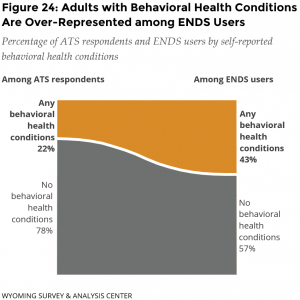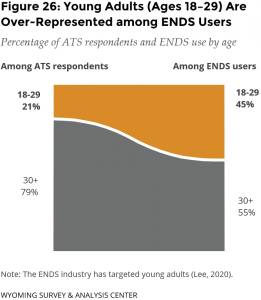Goal Area 4: Identifying and Eliminating ENDS-Related Disparities
Generations-long inequities in social, economic, and environmental conditions contribute to poor health outcomes. Breakdowns by race, ethnicity, or socioeconomic status may reflect where a person lives, works, or plays rather than the individual’s characteristics or personal choices (CDC, 2022c). These inequities have a greater impact on health outcomes than individual choices.
Addressing these health inequities is the fourth goal of the SUTPP and the CDC with the aim to reduce commercial tobacco and nicotine use and the related health burdens among populations disproportionately impacted by tobacco-related disease and death.
Starting in 2019, the SUTPP identified two priority groups that were unequally impacted by ENDS use: people experiencing behavioral health conditions and young adults (age 18–29). The SUTPP has two other priority populations to tobacco and nicotine prevention efforts: American Indians and people with low incomes.
The ENDS industry has targeted American Indians with ENDS marketing efforts (Field, 2020). However, in Wyoming, the data do not consistently show disproportionate ENDS use for American Indians. This may be a result of the small sample size for this population. For the 2021 ATS, fewer than 50 ENDS users said they were American Indians, including multi-racial people who included American Indian as part of their identification.
Unlike for smoking, income does not appear related to adults’ ENDS use in the ATS 2021 data.
For each population, we analyzed three key indicators: the prevalence of use, quit attempts, and exposure to secondhand smoke or ENDS aerosol.
The 2021 ATS included follow-up questions about quitting ENDS use. Fewer than 50 ENDS users within each priority population answered those questions. That is insufficient data for a precise estimate of lifetime and past year quit attempts in this report. WYSAC is available to discuss the data and associated limitations with interested parties.
For context, the overall vaping rate is 8%.
Behavioral Health
Historically, the tobacco industry has targeted people experiencing behavioral health conditions (such as depressive disorder, bipolar disorder, substance use disorder, and psychotic disorder; Prochaska et al., 2017; Campbell et al., 2016). More research is needed to understand if the ENDS industry is also using focused marketing toward people experiencing behavioral health conditions.
For context, the 2021 ATS asked respondents “Do you have any mental health conditions, such as an anxiety disorder, depression disorder, bipolar disorder, schizophrenia, Attention-Deficit/Hyperactivity Disorder (ADHD), Post-Traumatic Stress Disorder (PTSD) or substance use disorder?” About one fifth (22%) of adults reported having at least one behavioral health condition.
As with any self-report data, it is possible that people under-reported health conditions on the ATS, especially those conditions that may have stigma attached such as behavioral health conditions.
ENDS Use
Adults who said they had at least one behavioral health condition (15%) were statistically significantly more likely to use ENDS than adults who did not have at least one behavioral health condition (6%).
Adults with behavioral health conditions are over-represented among ENDS users (Figure 24). Only 22% of adults who responded to the survey reported having behavioral health conditions, yet they made up 43% of current ENDS users in the survey.

Exposure to ENDS Aerosol in Indoor Public Places
In 2021, 81% of adults with behavioral health conditions were not exposed to someone else’s ENDS aerosol in indoor public places in the past seven days. Significantly more adults with behavioral health conditions were exposed to ENDS aerosol in indoor public places than those with no behavioral health conditions (Figure 25).

Young Adults
Much like the tobacco industry has targeted youth (Farber & Folan, 2017), the ENDS industry has targeted young adults with advertising and marketing (Lee et al., 2020). The ENDS industry uses social media as a pathway to reach young adults (Lee et al., 2020). The ENDS industry’s focused efforts have contributed to disproportionately higher ENDS use rates for young adults.
WYSAC considered respondents as young adults when they were between the ages of 18 and 29 to increase the sample size and improve the reliability of estimates for this group. In 2021, 15% of Wyoming’s population was young adults (CDC, 2023).
ENDS Use
Young adults (18%) were statistically significantly more likely to use ENDS than other adults (6%). ENDS use may lead to later initiation of smoking, but more research is needed to investigate this potential pathway to smoking.
Young adults are over-represented among ENDS users (Figure 26). Only 21% of adults who responded to the survey were between the ages of 18 and 29, yet they made up 45% of current ENDS users in the survey.

Exposure to ENDS Aerosol in Indoor Public Places
In 2021, 76% of young adults were not exposed to someone else’s ENDS aerosol in indoor public places in the past seven days. Exposure to ENDS aerosol in indoor public places was about three times more common for young adults than for other adults (Figure 27).

Conclusions
The 2021 ATS data highlight the impact of the ENDS industry’s targeted efforts to engage already vulnerable populations in nicotine use. People experiencing behavioral health conditions and young adults (ages 18-29) are disproportionately affected by ENDS use.
People experiencing behavioral health conditions were significantly more likely to use ENDS than those without behavioral health conditions. They were also significantly more likely to be exposed to someone else’s ENDS aerosol in a public place in the last week.
Young adults are significantly more likely to use ENDS than other adults (age 30 and older).
Although most adults were not exposed to ENDS aerosol in public places, exposure was significantly higher for young adults.
These communities carry disproportionate burdens of ENDS use. Work related to Goal 4 of the SUTPP is essential to combat targeted efforts from the ENDS industry to eliminate these disparities and work toward health equity. Evidence-based ways to reduce these disparities include developing equitable policies, programs, and systems (CDC, 2022c).
Acknowledgement
Proportion plots adapted from a template distributed by Stephanie Evergreen: https://stephanieevergreen.com/proportion-plots/

